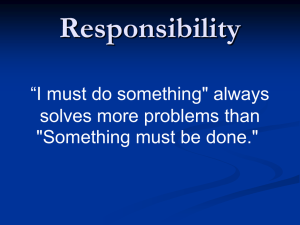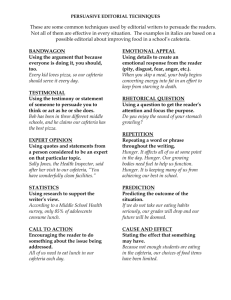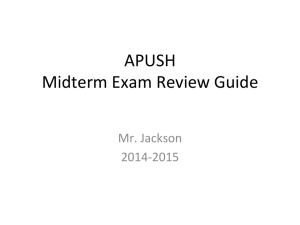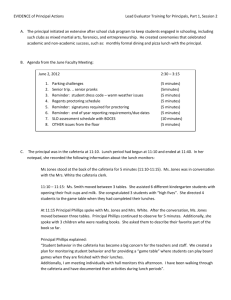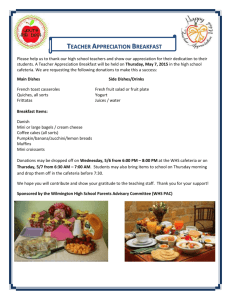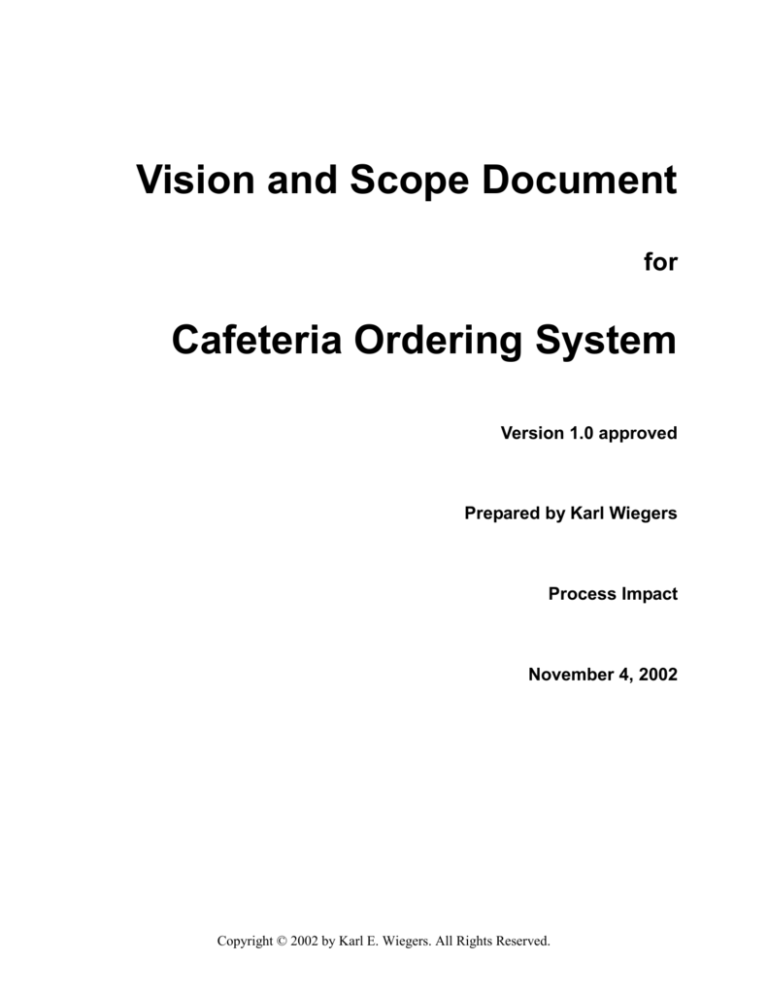
Vision and Scope Document
for
Cafeteria Ordering System
Version 1.0 approved
Prepared by Karl Wiegers
Process Impact
November 4, 2002
Copyright © 2002 by Karl E. Wiegers. All Rights Reserved.
Vision and Scope for Cafeteria Ordering System
Page ii
Table of Contents
Table of Contents ................................................................................................................ ii
Revision History ................................................................................................................. ii
1. Business Requirements ................................................................................................. 1
1.1. Background, Business Opportunity, and Customer Needs.................................... 1
1.2. Business Objectives and Success Criteria ............................................................. 1
1.3. Business Risks ....................................................................................................... 2
2. Vision of the Solution ................................................................................................... 2
2.1. Vision Statement.................................................................................................... 2
2.2. Major Features ....................................................................................................... 2
2.3. Assumptions and Dependencies ............................................................................ 2
3. Scope and Limitations................................................................................................... 3
3.1. Scope of Initial and Subsequent Releases ............................................................. 3
3.2. Limitations and Exclusions ................................................................................... 3
4. Business Context........................................................................................................... 4
4.1. Stakeholder Profiles ............................................................................................... 4
4.2. Project Priorities .................................................................................................... 5
Revision History
Name
Date
Reason For Changes
Version
Karl Wiegers
Karl Wiegers
10/13/02
11/4/02
initial draft
baseline following changes after inspection
1.0 draft 1
1.0 approved
Copyright © 2002 by Karl E. Wiegers. All Rights Reserved.
Vision and Scope for Cafeteria Ordering System
Page 1
1. Business Requirements
1.1. Background, Business Opportunity, and Customer Needs
A majority of Process Impact employees presently spend an average of 60 minutes per day going
to the cafeteria to select, purchase, and eat lunch. About 20 minutes of this time is spent walking
to and from the cafeteria, selecting their meals, and paying for their meals by cash or credit card.
When employees go out for lunch, they spend an average of 90 minutes off-site. Some employees phone the cafeteria in advance to order a meal to be ready for them to pick up. Employees
don’t always get the selections they want because the cafeteria runs out of certain items. The cafeteria wastes a significant quantity of food that is not purchased and must be thrown away. These
same issues apply to breakfast and supper, although far fewer employees use the cafeteria for
those meals than for lunch.
Many employees have requested a system that would permit a cafeteria user to order meals online, to be delivered to a designated company location at a specified time and date. Such a system
would save those employees who use the service considerable time and it would increase the
chance of them getting the food items they prefer. This would improve both their quality of work
life and their productivity. Knowing what food items customers want in advance would reduce
wastage in the cafeteria and would improve the efficiency of cafeteria staff. The future ability for
employees to order meals for delivery from local restaurants would make a wider range of choices available to employees and provides the possibility of cost savings through volume purchase
agreements with the restaurants. It might also permit Process Impact to have the cafeteria handle
only individual lunches, relying on restaurants to fill orders for breakfasts, dinners, special
events, and weekend meals.
1.2. Business Objectives and Success Criteria
BO-1: Reduce cafeteria food wastage by 50% within 6 months following initial release.1
Scale: Value of food thrown away each week by cafeteria staff.
Meter: Examination of Cafeteria Inventory System logs
Past [2002, initial study]: 30%
Plan: Less than 15%
Must: Less than 20%
BO-2: Reduce cafeteria operating costs by 15% within 12 months following initial release.
BO-3: Increase average effective work time by 20 minutes per employee per day within 3
months following initial release.
SC-1: Have 75% of those employees who presently use the cafeteria use the Cafeteria Ordering
System within 6 months following initial release.
SC-2: Achieve an increase in the average rating on the quarterly cafeteria satisfaction survey of
0.5 within 3 months following initial release and 1.0 within 12 months following initial
release.
1
This example shows the use of Planguage as a way to precisely state a business objective or other re-
quirement.
Copyright © 2002 by Karl E. Wiegers. All Rights Reserved.
Vision and Scope for Cafeteria Ordering System
Page 2
1.3. Business Risks
RI-1: The Cafeteria Employees Union might require that their contract be renegotiated to reflect the new employee roles and cafeteria hours of operation. (Probability = 0.6; Impact
= 3)
RI-2: Too few employees might use the system, reducing the return on investment from the
system development and the changes in cafeteria operating procedures. (Probability =0.3;
Impact = 9)
RI-3: Local restaurants might not agree to offer price reductions to justify employees using the
system, which would reduce employee satisfaction with the system and possibly their usage of it. (Probability = 0.4; Impact = 3)
2. Vision of the Solution
2.1. Vision Statement
For employees who wish to order meals from the company cafeteria or from local restaurants online, the Cafeteria Ordering System is an Internet-based application that will accept individual or
group meal orders, process payments, and trigger delivery of the prepared meals to a designated
location on the Process Impact campus. Unlike the current telephone and manual ordering processes, employees who use the Cafeteria Ordering System will not have to go to the cafeteria to
get their meals, which will save them time and will increase the food choices available to them.
2.2. Major Features
FE-1:
FE-2:
FE-3:
FE-4:
FE-5:
FE-6:
FE-7:
FE-8:
FE-9:
Order meals from the cafeteria menu to be picked up or delivered
Order meals from local restaurants to be delivered
Create, view, modify, and delete meal service subscriptions
Register for meal payment options
Request meal delivery
Create, view, modify, and delete cafeteria menus
Order custom meals that aren’t on the cafeteria menu
Produce recipes and ingredient lists for custom meals from cafeteria
Provide system access through corporate Intranet or through outside Internet access by
authorized employees
2.3. Assumptions and Dependencies
AS-1: Intranet-enabled computers and printers will be available in the cafeteria to permit cafeteria employees to process the expected volume of orders without missing any delivery
time windows.
AS-2: Cafeteria staff and vehicles will be available to deliver all orders within 15 minutes of the
requested delivery time.
DE-1: If a restaurant has its own on-line ordering system, the Cafeteria Ordering System must
be able to communicate with it bidirectionally.
Copyright © 2002 by Karl E. Wiegers. All Rights Reserved.
Vision and Scope for Cafeteria Ordering System
Page 3
3. Scope and Limitations
3.1. Scope of Initial and Subsequent Releases
Feature
FE-1
FE-2
FE-3
FE-4
FE-5
FE-6
FE-7
FE-8
FE-9
Release 1
Release 2
Standard meals from lunch
menu only; delivery orders
may be paid for only by payroll deduction
Not implemented
Implemented if time permits
(medium priority)
Register for payroll deduction payments only
Meals will be delivered only
to company campus sites,
not to off-site locations
Fully implemented
Not implemented
Not implemented
Fully implemented
Accept orders for breakfasts
and dinners, in addition to
lunches; accept credit and
debit card payments
Not implemented
Fully implemented
Release 3
Fully implemented
Register for credit card and
debit card payments
Add delivery from cafeteria
to selected off-site locations
Not implemented
Fully implemented
Fully implemented
3.2. Limitations and Exclusions
LI-1: Some food items that are available from the cafeteria will not be suitable for delivery, so
the menus available to patrons of the Cafeteria Ordering System will be a subset of the
full cafeteria menus.
LI-2: The Cafeteria Ordering System shall be used only for the cafeteria at the main Process
Impact campus in Clackamas, Oregon.
Copyright © 2002 by Karl E. Wiegers. All Rights Reserved.
Vision and Scope for Cafeteria Ordering System
Page 4
4. Business Context
4.1. Stakeholder Profiles
Stakeholder
Major Value
Attitudes
Corporate
Management
improved employee
productivity; cost
savings for cafeteria
Cafeteria Staff
more efficient use
of staff time
throughout the day;
higher customer
satisfaction
better food selection; time savings;
convenience
strong commitment
through release 2;
support for release
3 contingent on earlier results
concern about union relationships
and possible downsizing; otherwise
receptive
strong enthusiasm,
but might not use it
as much as expected because of
social value of eating lunches in cafeteria and restaurants
not happy about the
software work
needed, but recognizes the value to
the company and
employees
receptive but cautious
Patrons
Payroll Department
no benefit; needs to
set up payroll deduction registration
scheme
Restaurant
Managers
increased sales;
marketing exposure
to generate new
customers
Major Interests
Constraints
cost savings must
exceed development and usage
costs
none identified
job preservation
training for staff in
Internet usage
needed; delivery
staff and vehicles
needed
access to corporate
Intranet is needed
simplicity of use;
reliability of delivery; availability of
food choices
minimal changes in
current payroll applications
no resources yet
committed to make
software changes
minimal new technology needed;
concern about resources and costs
of delivering meals
might not have staff
and capacity to
handle order levels;
might need to get
Internet access
Copyright © 2002 by Karl E. Wiegers. All Rights Reserved.
Vision and Scope for Cafeteria Ordering System
Page 5
4.2. Project Priorities
Dimension Driver
Constraint
release 1 planned to be
available by 3/1/03, release 2 by 5/1/03; overrun
of up to 3 weeks acceptable without sponsor
review
Schedule
All features scheduled for
release 1.0 must be fully operational
95% of user acceptance tests
must pass; all security tests
must pass; compliance with
corporate security standards
must be demonstrated for all
secure transactions
Features
Quality
Staff
Cost
Degree of Freedom
projected team size is halftime project manager, 2
developers, and half-time
tester; additional half-time
developer and half-time
tester will be available if
necessary
budget overrun up to 15%
acceptable without sponsor review
Copyright © 2002 by Karl E. Wiegers. All Rights Reserved.



